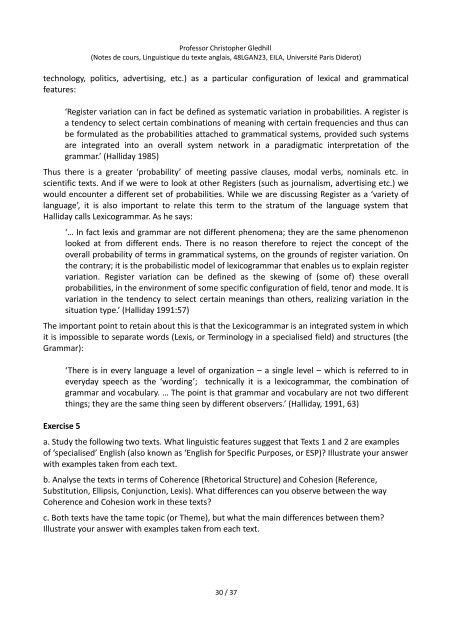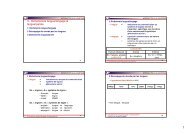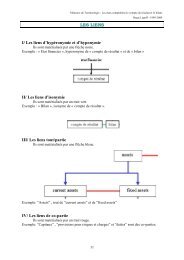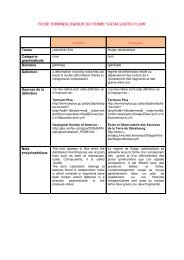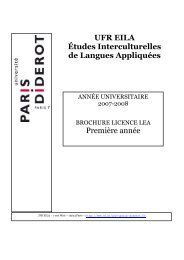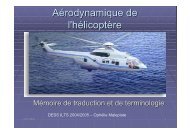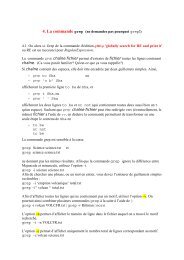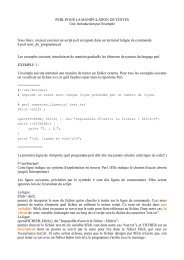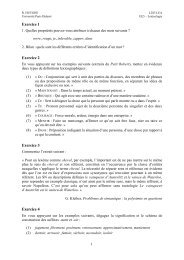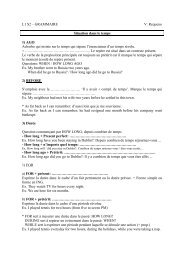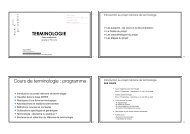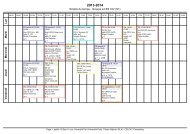INTRODUCTION TO ENGLISH TEXT LINGUISTICS
INTRODUCTION TO ENGLISH TEXT LINGUISTICS
INTRODUCTION TO ENGLISH TEXT LINGUISTICS
You also want an ePaper? Increase the reach of your titles
YUMPU automatically turns print PDFs into web optimized ePapers that Google loves.
Professor Christopher Gledhill<br />
(Notes de cours, Linguistique du texte anglais, 48LGAN23, EILA, Université Paris Diderot)<br />
technology, politics, advertising, etc.) as a particular configuration of lexical and grammatical<br />
features:<br />
‘Register variation can in fact be defined as systematic variation in probabilities. A register is<br />
a tendency to select certain combinations of meaning with certain frequencies and thus can<br />
be formulated as the probabilities attached to grammatical systems, provided such systems<br />
are integrated into an overall system network in a paradigmatic interpretation of the<br />
grammar.’ (Halliday 1985)<br />
Thus there is a greater ‘probability’ of meeting passive clauses, modal verbs, nominals etc. in<br />
scientific texts. And if we were to look at other Registers (such as journalism, advertising etc.) we<br />
would encounter a different set of probabilities. While we are discussing Register as a ‘variety of<br />
language’, it is also important to relate this term to the stratum of the language system that<br />
Halliday calls Lexicogrammar. As he says:<br />
‘… In fact lexis and grammar are not different phenomena; they are the same phenomenon<br />
looked at from different ends. There is no reason therefore to reject the concept of the<br />
overall probability of terms in grammatical systems, on the grounds of register variation. On<br />
the contrary; it is the probabilistic model of lexicogrammar that enables us to explain register<br />
variation. Register variation can be defined as the skewing of (some of) these overall<br />
probabilities, in the environment of some specific configuration of field, tenor and mode. It is<br />
variation in the tendency to select certain meanings than others, realizing variation in the<br />
situation type.’ (Halliday 1991:57)<br />
The important point to retain about this is that the Lexicogrammar is an integrated system in which<br />
it is impossible to separate words (Lexis, or Terminology in a specialised field) and structures (the<br />
Grammar):<br />
Exercise 5<br />
‘There is in every language a level of organization – a single level – which is referred to in<br />
everyday speech as the ‘wording’; technically it is a lexicogrammar, the combination of<br />
grammar and vocabulary. … The point is that grammar and vocabulary are not two different<br />
things; they are the same thing seen by different observers.’ (Halliday, 1991, 63)<br />
a. Study the following two texts. What linguistic features suggest that Texts 1 and 2 are examples<br />
of ‘specialised’ English (also known as ‘English for Specific Purposes, or ESP)? Illustrate your answer<br />
with examples taken from each text.<br />
b. Analyse the texts in terms of Coherence (Rhetorical Structure) and Cohesion (Reference,<br />
Substitution, Ellipsis, Conjunction, Lexis). What differences can you observe between the way<br />
Coherence and Cohesion work in these texts?<br />
c. Both texts have the tame topic (or Theme), but what the main differences between them?<br />
Illustrate your answer with examples taken from each text.<br />
30 / 37


